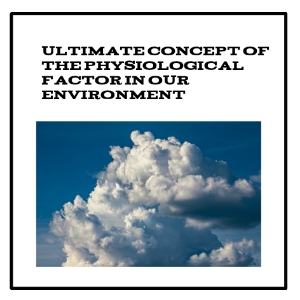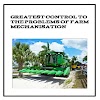Effects of changes in Climate on Growth.
Changes in Climate have some effects on the farm animals which includes:
1. High temperature of about 39°C help chick develop very well but the excess heat can make the chicks to pants.
2. Extremely cold or hot conditions is unfavorable and reduces the performance of farm animals.
3. High relative humidity affect food intake of farm animals.
4. Extreme low temperature leads to retarded growth or even death of chicks.
5. Winds is an agent of air borne disease like tuberculosis which can cause retarded growth or even death of animals.
6. Tsetse flies multiplies when there is high rainfall which can transmit trypanosomiasis and such diseases reduce the growth or even leads to death of farm animals.
7. High relative humidity leads to heat stress in farm animals like cattle, pig, poultry etc.
8. The intake of food is affected by high intensity of radiation.
9. At low temperature, the is reduced feed efficiency as more nutrients are needed for body maintenance leading to poor growth in animals.
10. Huddling or suffocation increases in birds mortality in low temperatures.
11. High humidity in poultry houses causes mouldines of feed; thereby leading to low feed intake and retarded growth.
12. At high temperatures also, feather coverage on the body of chicks are poorly developed which may be leading to pecking.
13. Moderate wind velocity promotes good ventilation and this enhances the normal growth of farm animals. Extreme wind have negative impact on animals and helps in spreading of weeds .
Effect of changes in Climate on Reproduction
Changes in climate have some effects on reproduction of farm animals. These effects are:
1. Heat stress e.g high temperatures can cause abortion in farm animals.
2. High relative humidity affects the productivity of farm animals.
3. High intensity of radiation cause heat stress in farm animals and thus reduces the reproductive capabilities.
4. High temperature leads to low rate of conception and fertilization in farm animals.
5. High temperature decreases or reduces heat period in farm animals leading to low reproductive capability.
6. High rainfall and high humidity cause the chilling of young ones soon after parturition.
7. Ovulation in animals decreases with high temperature.
8. The frequency mating decreases the quality and quantity of semem in breeder birds die to high temperature.
9. Hatchability and fertility in birds breeders decreases due to high temperature.
Effects of changes in climate on milk production
Changes in climate have a great effects on milk production by farm animals. These effects includes:
1. High relative humidity favours the growth of disease pathogens that can reduces milk production in farm animals.
2. High temperature and rainfall do not favour the rearing of diary animals.
3. High temperature reduces the rate of milk production in farm animals.
4. Tsetse flies multiplies in high rainfall and thereby transmitting trypanosomiasis in dairy cow, thereby leading to low milk production.
5. Animals get stressed when there is high intensity of radiation and hereby reducing their milk production.
6. Animal do not eat well in the season of heavy rainfall due to poor growth of grasses and low feeding can cause less milk production by farm animals.
Effects of changes in climate on egg production
(a) Temperature
(I) High temperature cause reduction in feed intake while low temperature encourage more feed intake and more feed intake enhances the formation of eggs.
(ii) High temperature reduces hatchability of eggs.
(iii) Under high temperature, egg storage periods is reduced.
(iv) High temperature causes heat stress and reduced.
(v) High temperature lowers egg production.
(vi) High temperature increases the water intake and cold temperature reduces water intake.
(vii) High temperature can cause death in birds, particularly chicks and layers.
(viii) High temperature is necessary for eggs incubation.
Control of Heat/Temperature
1. Room heaters and lanterns should be introduced to make the building warm when it's cold.
2. During construction of some parts of farm building, keep the open parts of buildings away from direct solar radiation.
3. Windows should be covered with cloth materials to conserve heat.
4. Vents should be provided at the roof tops.
5. Fans and air conditioner should be used.
6. Poor conductors of heat should be as the roofing sheet. Sin reflecting sheets can also be used or the roofs should be painted with white. Pens should also have ceiling boards under the roofs.
7. There should be enough windows or opening for ventilation should be provided.
(b) Relative Humidity
(i) Relative Humidity is very important in the incubation of eggs m
(ii) High humidity causes feeds to get mouldy.
(iii) High humidity promotes the spread of diseases.
(iv) Low humidity induces rapid water loss from bird's body and it increases their water intakes.
(v) Heat stress is caused by high humidity.
Control of humidity
1. Fix humidifiers or open trays filled with water to increase humidity.
2. Free ventilation should be allowed when the humidity is high.
3. Spilling of water in poultry houses should be stopped to reduces humidity or dampness.
(c) Light
(i) It controls egg layering in hen
(ii) Light makes object visible.
(iii) Bright lights makes the birds active
(iv) Direct light of high intensity causes stress to the eyes.
(v) Duration of lighting controls time spent at feeding which regulates growth and the rate of feathering.
Control of Light
(I) In short day, extra illumination should be available.
(ii) Windows should be covered with dark light to reduces light intensity when there's excess light.
(iii) Some parts of the walls should be made up of wire to promote lighting.








3 Comments
Good Post
ReplyDeleteThanks fortgef reply...
DeleteThanks for the reply.....
Delete